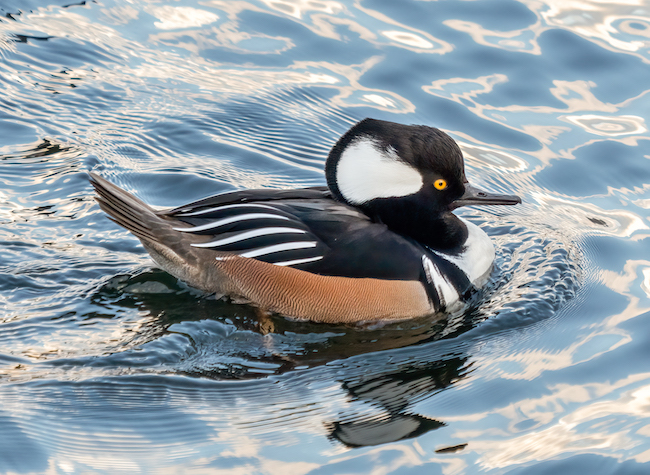BY HARRY WEEKES
Anne Lamott’s book “Bird by Bird” is subtitled “Some Instructions on Writing and Life.” If I remember the title story correctly, Anne’s brother procrastinated on a major assignment regarding birds. He had to do a report on dozens of our feathered friends, due the next day, to which his father gave him the advice and direction of “bird by bird.” In other words, start on the first one and keep going until you’re done.
Not only is this sound advice for writers (“start one word, one sentence, one thought at a time”), it is also the best birding advice I have been given. “When you get to clumps of birds, go through them one bird at a time.”
Birds come to Indian Creek pond in the winter. There are kingfishers and great blue herons, chickadees flitting about the willows, and here and there small rafts of ducks.
As I get closer to the pond, before even lifting binoculars, I am already identifying them: the great puddlers glide along the edges—the mallards and wigeons and gadwalls—and out in the deeper water are the divers—the ringneckeds and the goldeneyes. Each has a suite of general characteristics—color, posture, location—that direct me down the rough cut of recognition. The binoculars let me confirm who is present and also see their details.
The drake mallard’s glossy green head and curled up feathers on the tail. The white mohawk of the male American wigeon. The expanse of white on the… wait a minute. That’s on the head! Even though the eye is golden, that is no goldeneye.
My scanning stopped, and there, for the first time I have seen one in Indian Creek, drifted a male hooded merganser.
Then the dual magic of pausing took over. On one hand, I got to observe the merganser. His bold white head crested with a black stripe. His brilliant yellow eye, which opened just long enough to direct a quick spin and set him in the opposite direction. His chestnut flanks and white wing bars.
On the other hand, I got to see the other birds more deeply, too. The merganser drifted in front of the mallards, at once showing his diminutive size and highlighting their relative enormity. The merganser floated with his head turned back, crossing paths with Barrow’s goldeneyes, showing the stark difference between one’s wing stripes and the other’s wing dots. When he stretched out his head at one point, he revealed a flat, sharp bill that was obviously honed for a different kind of aquatic delicacy than the thick, deeper bill of the ringnecked duck.
This smallest of our mergansers gave me at least two presents—one of getting to see him, and the other of getting to see more deeply the birds I already know.
When I returned the next day, as I suspected, the merganser was gone. This time, the bright white patches on the opposite shore were the underbellies of several goldeneyes doing their signature aquatic side-preen. I took this in, noticing the wonderful orange toes of this little diving duck. In front of them, the glossy heads of the ringneckeds shimmered a kind of purple as they pushed around the water. And behind, a female mallard quacked stereotypically as she pulled at her bright wing bars.
Ultimately, the merganser helped me see differently and a little better simply by encouraging me to take the time to see what was already there. Now that’s a pint-sized duck present I can continue to unwrap.
Harry Weekes is the founder and head of school at The Sage School in Hailey. This is his 52nd year in the Wood River Valley, where he lives with Hilary and one of their three baby adults—Simon. The other members of the flock are Georgia and Penelope (Georgia recently fledged from Davidson College in North Carolina and Penelope is at Middlebury College in Vermont).



